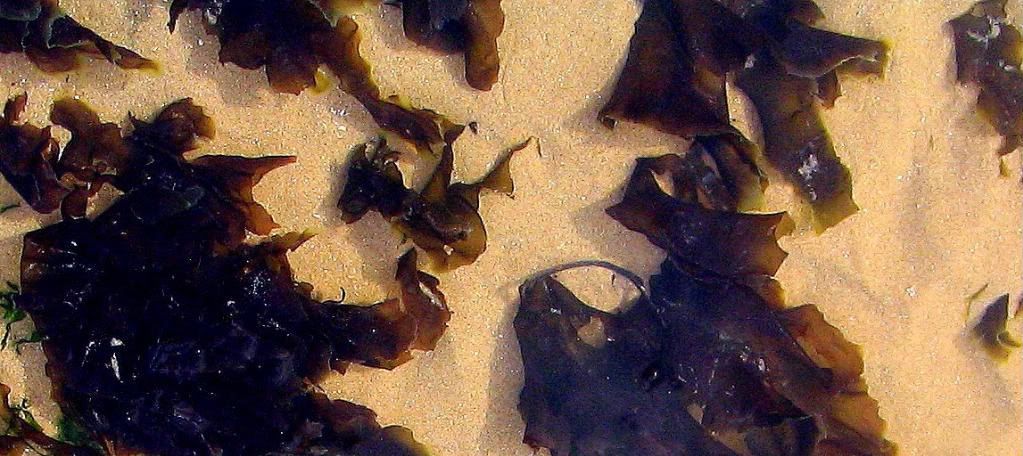I LOVE
Quite hard to get hold of in most areas of the UK I have found unless you buy it in a tin or are lucky enough to have a fishmonger that can get you some fresh from the freezer...
The other day I was lucky enough to find a load of this Black Gold growing off the rocks in Rhossili Bay so I decided to to do an experiment and have ago a processing it myself.
Below are the pictures and the details of making it
What you'll need:-
A Big Pan with a lid
Fresh Lava Bread (I picked enough to fill a small green grocers bag after squeezing excess sea water out)
A Large Bowl
A Colander
A Mincer
Squeeze laver bread thoroughly to remove excess sea water place in the sink or a bowl of fresh cold water leave to soak overnight changing the water several times.
Once again squeeze the laver bread and place in a big pan of boiling water (about a kettle and a half full). Simmer for around 4 ½ - 5 hours (it can be pressure cooked for about 1½ hours apparently but I haven’t tried this.)
Stirring occasionally to prevent it sticking the laver will look “gloopy” and quite thick and soft.
Over the sink drain the laver in a colander leave to cool then squeeze the laver well to remove the excess “gloop” (I use my hands for this but I was advised to place laver in a tea towel to squeeze out the gloop).
Place your laver in a hand mincer and mince (or simply chop if you don’t have a mincer) season with a little salt and a small dash of vinegar.
Shape your laver into small cakes before rolling in oatmeal and frying until cooked in bacon fat (Rich insists it must be home cured bacon fat!).
I have a few good recipes for laver bread I’ll add to this post later







I'm not convinced it's practical the "olde" way producing this "black gold" in the olde days 6 hrs plus was nothing on the boil in a pot, in this day and age we don't have a pot on an open fire 24/7.
So I experimented... 1 hr in a steamer (conventional veg steamer) bloodly marvellious!!!
No fuss waste, totally 110% pure goodness!
I managed to yeald 1/2 lb of laver from 1 carrier bag of seaweed! it tbh tastes better than the Penclawdd Laver bread!!! :smt117
Wash as above well, add few small grains of Potassium Permanganate baught from most chemists leave to soak for 1/2 hr and rinse thouroughly until the water is clear (this removes any nasty's in the laver)
Squeeze out excess water and place the laver in a vegtable steamer for 1- 1 1/2 hours


After it has cooled chop or mince not in a blender as the blender will break lol...
Season with a dash of pepper and vinegar and salt, careful on the salt tho!
Your lavers now ready for bagging up for the freezer or the recipe you choose to use it in fresh
This page is dedicated to my old camera R.I.P (I sorta killed it :smt049 takeing these pictures cos' of the steam from the pan on the boil for 5 hours :smt011 )
* No Welsh People I force Fed This To Where Harmed or Poisoned In My Experiment ROFL ROFL ROFL
Found some intresting information on Laver Bread :-
The shiny black delicacy has been eaten in Britain for centuries.
Laver (porphyra umbilicalis) lies flat on rocks with its long flowing fronds under water. It is particularly found in parts of Gower though a lot of commercial laver used in the UK is harvested from Scotland.
Laver is unique among seaweeds being only one cell thick.
It is known as nori in Japan where locals cannot get enough of it. A total of nine billion sheets of nori are consumed there each year, mostly in sushi meals.
Laver bread was probably first eaten as "survival food" possibly by people forced from their homes and usual food sources by Roman or Viking invaders.
Camden's Britannica recorded it as a food in 1607. It was referred to as "lhawvan".
The journal described it being harvested from Eglwys Abernon Beach near St Davids in Pembrokeshire and in 1797 it was reported that earthenware jars of pickled porphyra were being exported from Watchet in Somerset.
When coal mining was widespread in Wales, laver bread (a mixture of seaweed and oatmeal) and bacon, mushrooms and sausages became a staple breakfast for hard-working pitmen who needed plenty of energy.
In 1865 George Borrow on his travels through "Wild Wales" mentioned "moor mutton and piping hot laver sauce" as one of South Wales' great dishes.
Seaweed eating is not only tasty, it is good for you. One scientific study after another has testified to the health giving qualities of the wavy weed which is said to get its goodness by being bathed in the mineral rich sea. It contains more than 50 known minerals and trace elements regarded as essential body requirements. It provides high quantities of potassium, iodine, iron, magnesium and calcium.
Laver bread is so healthy it could even help after a nuclear pollution incident. It contains sodium alginate, a compound which binds with heavy metals found in the gastrointestinal tract forming a gel-like salt which has been said to eliminate radioactive and environmental contaminants.
And seaweeds are healing to the mucous membranes, promote healthy skin, and also enhance the flexibility and mobility of joints.
Many seaweed species grow across the intertidal zone and below low water from the Arctic to North Africa and other similar latitudes.
The edible types can be roughly categorised into the finer weeds as laver and sea lettuce, the short stemmed as dulse, Irish moss or Carragheen and "horse tail" kelps which grow on or below the tide mark.
Laver is the most prized for its versatility in cooking.
And at this time of the year it could save thousands of lives and free up as many hospital beds.
Scientists in Japan believe laver bread could be used to fight "the winter killer", flu. Researchers at Saga University have identified a chemical known as MC26 in laverbread which could even be used to fight Aids. Yuto Karmei, who led the study, said MC26 was more successful in fighting flu than amantadine hydrochloride which forms the basis of many modern flu remedies.
Welsh chefs use laver bread in a variety of ways with the traditional breakfast mixture of laver bread, cockles, bacon, mushrooms and sausages.
Dulse Dried (laver, Nori)
Organic
Nutritional Information
Measurement Unit 0.3 cup
Cal. 18
Cal. from Fat 0
Total Fat 0
Sat. Fat 0
Trans Fat 0
Cholesterol 0
Sodium 122
Total Carb. 3
Dietary Fiber 0
Sugars 0
Protein 2
Vit A 0
Vit C 0.4
Calcium 15
Iron 2.3
Additional Nutritional Information
Measurement Unit 0.3 cup
Food Energy (kj) 75.3
Phosphorus (mg) 29
Magnesium (mg) 19
% Calories from Carbohydrates 60
Vit-E (IU) 0.1
Est. Net Carbs (g) 1
Potassium (mg) 547
Copper (mg) 0
VEG 0.7
Zinc (mg) 0.2
Calories from Carbohydrates 10.8
Vit-A IU 46
Fluroide (mg) 0.4
Calories from Protein 7.2
Vit-B1 Thiamine (mg) 0
Manganese (mg) 0.1
Iodine (mcg) 364
Vit-B2 Riboflavin (mg) 0.1
Vit-B12 Cyanocobalami (mcg) 0.5
Vit-B3 Niacin (mg) 0.1
Vit-B6 Pyridoxine (mg) 0.6
Chromium (mcg) 10.5
% Calories from Protein 40
Blaaaaa de blaaaaaaa.... seems it's very healthy in other words




